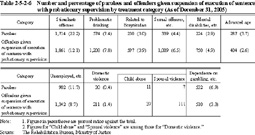| Previous Next Index Image Index Year Selection | |
|
|
2 Treatment for probationers and parolees In order to enhance the effects of probationary supervision, the classified treatment system and the categorized treatment system have been implemented. For parolees who were sentenced to life imprisonment or long-term imprisonment (eight years or longer term of sentence) and were accommodated in penal institutions for a long term, the intermediate treatment system is implemented for their smooth reintegration into society. Under the intermediate treatment system, those parolees live in halfway houses for one month after release and receive training for daily living. In 2005, the intermediate treatment system was implemented for 99 parolees (Source: The Rehabilitation Bureau, Ministry of Justice).
(1) Classified treatment system The classified treatment system was introduced in 1971. Based on the fixed criteria, parolees and offenders given suspension of execution of sentence with probationary supervision are classified into Class A or Class B according to the expected level of difficulty in treating them. For those classified into Class A who have grave problems with their predispositions and environments and are expected to be difficult to treat, probation officers in charge are required to communicate and consult with volunteer probation officers, and to make well-planned and intensive meetings with persons in question, their families, and related parties to give proper guidance and advice. Probation officers thus get involved in their treatment directly and deal with them intensively.
As of December 31, 2005, the Class A ratio (meaning the ratio of those considered difficult to treat) was 17.5% for parolees and 8.1% for offenders given suspension of execution of sentence with probationary supervision (Source: The Rehabilitation Bureau, Ministry of Justice). (2) Categorized treatment system The Categorized treatment system is a system whereby parolees and offenders given suspension of execution of sentence with probationary supervision are divided according to the nature of their crime or delinquency, environmental conditions and other circumstances, and supervision is carried out focusing on the characteristics of each category. This system was introduced in 1990, and the number of categories was revised in 2003.
Table 2-5-2-6 shows the major treatment categories of parolees and offenders given suspension of execution of sentence with probationary supervision (as of December 31, 2005). Table 2-5-2-6 Number and percentage of parolees and offenders given suspension of execution of sentence with probationary supervision by treatment category (As of December 31, 2005) Under this system, individual supervision is carried out based on the treatment manual prepared for each category, and in some probation offices, group treatment is also implemented for the persons in question or their families and guarantors. In FY2005, 22 offices held a total of 41 meetings for guarantors of stimulant drug offenders, and a total of 569 guarantors participated (Source: The Rehabilitation Bureau, Ministry of Justice). |
